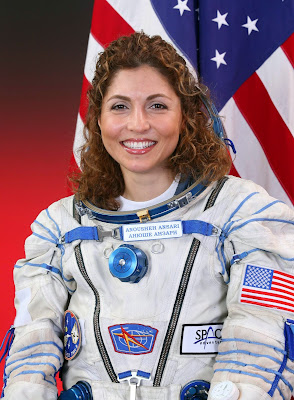 |
Anousheh Ansari, engineer and space tourist in 2006.
|
In my first posting on NASA astronauts, namely Gemini and Apollo crews, having little trouble walking after space flight missions (LINK), it seems that this phenomena also extends to the Space Shuttle astronauts as well. As shown in my original article, the effects of zero gravity on the human body are quite stressful and upon returning to earth walking can be difficult to impossible. Unless of course if you are a NASA astronauts. Russian cosmonauts and space tourists
In Mike Mullane’s book, Riding Rockets, it seems the Space Shuttle astronauts have no lasting effects of being Zero G after a 7 or 10 day mission into space. For example on page 402, Mullane mentions after the landing of flight STS-27 that the crew put on their blue jumpsuits and walked out of the orbiter. The mission length was 4 days so that probably helped in being able to walk off on their own. Although a Russian cosmonaut during a 5 day mission in the 1960’s could not walk upon landing. Mullane also mentions having trouble with his equilibrium after a flight but it was not enough to prevent walking (p.266).
The only reported NASA astronauts that have trouble walking are those that have spent a year on the ISS such as Scott Kelly and other astronauts that have spent a year or less in zero gravity.
Dennis Anthony Tito, the first space tourist spent 8 days on the ISS in 2001. He needed help getting out of the capsule and after being placed in a large chair, was carted off the landing field in Kazakstan. He could not walk. None of the 7 other space tourists could either and also had to be carted off.
Iranian-American engineer Anousheh Ansari’s has a blog about her stay on the ISS in 2006. On her blog (link below) she describes the sensation of reentering gravity after being weightless for 11 days. She needed help getting out of the capsule, needed assistance getting off the landing field and needed help getting out of her space suit. She could not walk at first and felt extremely heavy, the end result of not using muscles which normally endure resistance against gravity. Her experience illustrates that it does not take long for one to lose the ability to walk after being in space.
This raises the question of how could the Apollo astronauts walk on the moon in this condition. Or for that matter, how could they walk so easily after landing on earth?
So apparently, none of the NASA astronauts have trouble walking after being in space unless they are doing missions of six months or more. This is an issue with no resolution. Unless NASA has developed some secret technology, such as artificial gravity, of which there is no evidence of.
Either they went into space or they did not stay as long as they said they did. Regarding the latter, something that would be hard to fake.
End Notes
Page numbers from Riding Rockets are from the electronic version. Might be off from the printed edition since I usually enlarge the type on my tablet for easier reading.
Zero gravity is know commonly called “microgravity.” Same thing.
Anousheh Ansari spent three days in orbit and eight days on the International Space Station.
Sources
The Right Stuff Never Stumbles Part 1
Riding Rockets by Mike Mullane
Medical Effects of Spaceflight
